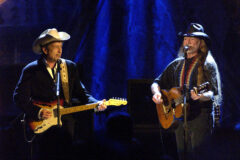Bob Dylan—just following the grueling saga surrounding his delayed acceptance of the Nobel Prize in Literature—has penned a new essay of Vanity Fair, entitled “Why Bob Dylan Paints.” Dylan did last month’s silence-breaking profile with the Telegraph, in which he first acknowledged the Nobel, to support the new show of his artwork going up in London this morning, “The Beaten Path.” The VF essay, too, focuses its discussion around that exhibition; it’s clear that, much more than whether or not his lyrics should be described as “literature,” he’s eager to discuss his paintings.
His exhibit at the Halycon Gallery consists entirely of American landscapes, and was commissioned from the museum. Dylan claims–just as he didn’t do after the Nobel Prize announcement–that he responded in the affirmative immediately (“All they had to do was say it once.”) He then explains his interest in working with landscapes with cryptic, lit-theoretical ideas about how important understanding tradition is to advancing art:
“I believe that the key to the future is in the remnants of the past. That you have to master the idioms of your own time before you can have any identity in the present tense. Your past begins the day you were born and to disregard it is cheating yourself of who you really are.”
The piece offers a view of Dylan’s proudly selective world, since he painted idealized landscapes rather than exactly what he saw in front of him: pre-modernization and gentrification. He describes his process when painting, avoiding corporate buildings, highrises, and branded billboards: “…these cold giant structures have no meaning for me in the world that I see or choose to see or be a part of or gain entrance to.” It’s Bob’s world and we’re just…well, sometimes we wish we understood it.
Dylan also reveals that he often paints from photographs prepared in specific ways to emulate camera obscura techniques from the 1600s, and that he is committed to stylistic realism. (“My idea is to compose works that create stability, working with generalized, universal, and easily identifiable objects,” he says.) It might seem like a parody of an Art Talk, but he does actually bring up the Dutch masters, and meaningfully.
He also spends a whole lot of time on how mathematically he approached the work, and how committed he was to not sensationalizing anything. The reason? To create something that could truly not be misunderstood. (One wonders if he believes that his other work has been.) He concludes:
“There is nothing to suggest these paintings were inspired by the writings of Sigmund Freud or that they were based on any mental images that occur in dreams, no fantasy worlds, religious mysticism or ambiguous subject matter. In every picture the viewer doesn’t have to wonder whether it’s an actual object or a delusional one. If the viewer visited where the picture actually existed, he or she would see the same thing. It is what unites us all.”
For Dylan fans, it’s not quite that amazing MusiCares speech, but it’s strong, revealing stuff. Dylan has historically frustrated and challenged us his audience by following his muse above all else, even if it seems to change just when they are starting to truly appreciate what he is doing. This is a rare moment in which we get Dylan conveying genuine passion about his latest project, and it’s an inspiring read.
Check out the article, and take VF‘s embedded 3D virtual tour of the space.





